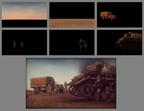 |
|||||||||
|
|
||||||||||||||||||
|
|
| Want to leave us a comment about the site or in general? Click here to access the form. |
 |
|
The making of 'Afrika Korps' cinematics by: Tamas Varga Added on: Mon May 24 2004 |
|
| Page: 1 2 3 4 5 6 7 8 9 | |
Some people like to criticise the Maya software renderer, however we've found it to be a capable production tool, perfectly fitting for video res (640-720 pixels) cinematics. With the proper shaders and some compositing, it can deliver great results, and we usually managed to keep render times under 2-5 minutes for one frame on our P3 render nodes. Lighting in all-CG scenes has a few typically problematic areas. First of all, shadows are usually depth maps which consume memory if the light has to cover large areas; and the map bias can be problematic to adjust if the light is too far from the object. Also, most objects will require several fill lights to brighten up shadowed areas, not to mention rim lights. The ground plane would recieve illumination from all of these lights, which would quickly wash out the colors. Our solution is to break up the scene into layers, and assign lights to layers individually. This way we can have different lights for the ground plane, characters, static and movind objects. Shadow attributes can be fine tuned individually, and we don't have to use light linking.
Robix has developed a simple and easy to use render layer manager script to help manage the process. Objects were packed into groups in Maya. "Layer" sets were then created from these groups, with a set usually containing the CAM group, and one or more Light group and Object group. It was possible to assign a Light group to more than one layer too, so shared lights did not have to be duplicated.
|
Best viewed in 1024x768 or higher,
using any modern CSS compliant browser.

